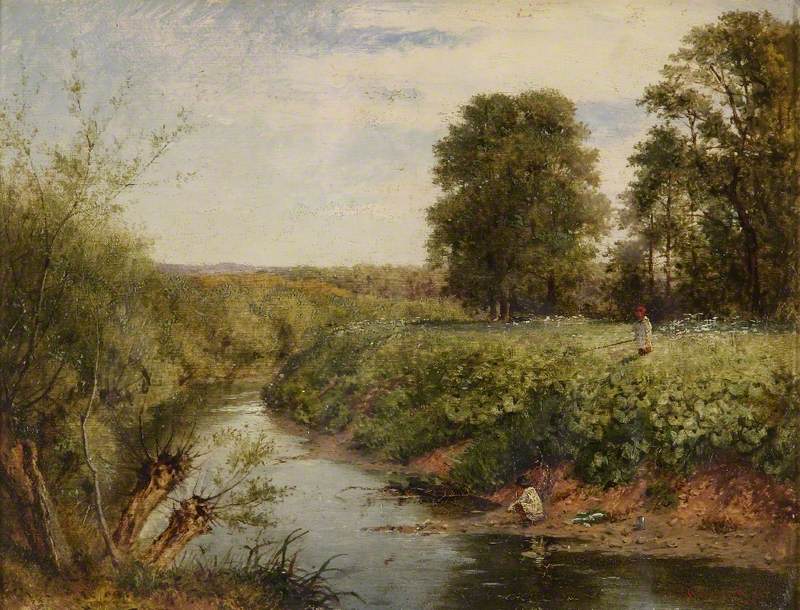Gainsborough's House in Sudbury, Suffolk, reopened in November 2022 after a £10.5m renovation and extension. You can literally smell the money: the foyer still has that unique tang of newness. You can certainly see it: the new extension is elegantly engineered into an awkward site; the façade employs the locally characteristic combination of brick and flint; the interior doors are so weighty you can barely open them; and their collection of Gainsboroughs are hung on a background of glorious green silk. And ultimately you pay for it: the entry fee, including temporary exhibitions is nearly £16.
The extension allows for two temporary exhibition spaces, the larger currently occupied by Gainsborough and the Legacy of Landscape: Masterpieces from Woburn Abbey. It is in all honesty a slightly disappointing show. The first section gives prominence to Gainsborough's commissions for the Duke of Bedford, a welcome reminder that the artist who is usually seen as a portraitist who wished he was a landscapist, was actually recognised as a painter of nature from early in his career. Landscape with Woodcutter and Milkmaid (1755), is a show-stopper in itself, in terms of scale (1m x 1.2m), execution and its intriguing narrative. The soft pinkish clouds give a rococo warmth to the artist's usual earthy, and sometimes dingy, palette. The composition is a ramshackle picturesque, Gainsborough's loose brushwork creating a countryside of exaggerated disorder, rutted lanes and knarled bark which mirrors the fluster of the milkmaid with her undone stays and her slipping shoe. The grouping of the figures and cow is almost Hogarthian in its style and innuendo and the slither of white milk just visible in the pail is a final masterful flourish.
The Dutch examples - and there are some fine works, notably Albert Cuyp's Artist Sketching Near Elten (1655) - clearly show both their influence on Gainsborough and on British art in general. However, the second part of the display, 'the legacy', is far less convincing. The wall text describes the family selling Dutch works in order to purchase contemporary British examples, but they might have been advised not to. The artist who most obviously picked up the baton from Gainsborough, John Constable, is overlooked in favour of Frederick Richard Lee and Augustus Wall Callcott both of whom seem stiff and contrived compared with what has gone before. Edwin Landseer, superb painter of animals though he was, seems much less interested in the generic rolling countryside behind the Deer in Coldbath Fields (1835). Instead we make the significant leap to Richard Parkes Bonington whose French influence takes art in a different direction. I can't fault the gallery space or the labelling but the exhibition fails to do real justice to its title.
What Gainsborough's House does boast is a wonderful collection of the artist's own works, some exhibited in a sensuously rich cocoon of dark wood and deep green silk, some in the intimacy of living spaces in the original house. The new gallery works well, sympathetic to Gainsborough's landscapes and making the portraits sing. One of my favourites of his early style, Peter Darnell Muilman, Charles Crokatt and William Keable in a Landscape (1750), has never looked better with the reds and whites emphasised and the youthful, bulbous nosed faces more expressive than I remember. Yet information is reduced to tombstone facts on large tatty cards strewn on a bench: they claim to be temporary but four months after opening, and given the opulence of the surroundings, they need to do better. Their own collection is boosted by loans, at present including the National Portrait Gallery's David Garrick (1770) who sparkles with urbane charm, and two head and shoulder images of his daughters, every brushstroke applied with paternal love and pride.
I wanted to enjoy Gainsborough's House but it was a frustrating experience. It seems so much less than the sum of its parts. Cedric Morris' display is crammed into a room in the old house. The silk exhibition, potentially very interesting, seems an underdeveloped afterthought. Who is going to benefit from the multi-million pound investment? I hope, though I'm not convinced, that it will encourage visitors into the town. If I lived locally I might resent the fact that this beautiful building and the art inside it was hidden behind such a significant paywall. Certainly, on the mid-week day I visited it was quiet, and it is difficult not to compare the experience unfavourably with a trip to Christchurch Mansion in nearby Ipswich, free and with an exhibition space attached, this was a bustle of engaged visitors.










